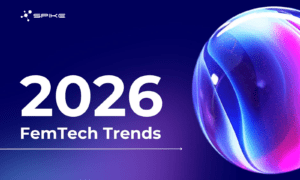An AI tool called Lovable.dev allows you to simply describe the app you want, and it will create a functional web application in a matter of minutes. For your developers to edit, it even provides you with the entire source code on GitHub. Although Lovable.dev demonstrated the potential of AI app development, these cutting-edge tools are already improving its speed, intelligence, and developer friendliness.
However, since Belitsoft is a custom software development company, we frequently get requests from teams that have developed a prototype on Lovable and are seeking senior support to put it into production. Lovable-like tools, in our opinion, are perfect for quick prototypes, personal portfolios, and small projects. Senior engineer supervision is probably necessary for large-scale applications or anything that requires a strong backend architecture. As one user pointed out, these tools handle repetitive tasks while the team focuses on the complex concerns. Therefore, human oversight is still essential.
Lovable Restrictions
Lacks analytics or feedback in real time
The process of using Lovable is essentially one-way: you give it instructions, and it generates code in response. It lacks performance and SEO insights by default, in contrast to conventional IDEs or development tools. Users have no performance dashboard or optimization guidance after Lovable creates a website, according to some reviews. Stated differently, developers are required to manually test performance (such as Lighthouse scores) after the code is created. Lovable is not monitoring the process while the user is building. As a result, the “no feedback” loop suggests that quality control is carried out only after the product is made available to the public, which causes the teams to put in more effort and lose confidence.
Limited support for errors and debugging
Although Lovable has a conversational chatbot and an AI “Try to Fix” feature, they typically aren’t able to fully resolve complex bugs. Developers often try the “Fix” command several times before getting the desired outcome, or it fails on complex logic, leaving them to solve the issue locally. In certain cases, users are unable to perform debugging tasks, like code execution or stack trace, through the web user interface (UI) due to the absence of an internal debugger or console. Quite often, some users have encountered Lovable “implementing features without the correct setup” (i.e., broken image APIs). In essence, Lovable’s error correction setup relies on the user identifying the flaw and asking the AI to try again; by default, computer testing and error reporting are not available. In his review, one of the critics points out that while standard developers use tools like testing suites and runtime logs, Lovable’s audience “would not be able to do it if those features were not there.”
Problems with scalability and code quality
When you want to quickly create a basic demo of an idea and present it to investors or test the market, Lovable.dev is a great tool to use. However, the tool experiences issues when standard features like “create, read, update, delete” records in a database are expanded to larger, more specialized, or highly customized projects. It has been demonstrated in real-world scenarios that the tool can only complete roughly 60–70% of the necessary work to achieve a production-ready application. Human developers are still required to complete the final 30–40%, and occasionally a significant amount of it. The true cause is that Lovable’s AI model lacks sufficient context or depth to enable seamless operation of sophisticated business rules, specialized integrations, or atypical workflows. Because of the “diminishing returns” effect, which occurs when project complexity increases, the more complex your app becomes, the less additional benefit you get from Lovable. Therefore, it is possible to see the hidden technical debt that has accumulated for a variety of reasons. For example, the auto-generated code may use deprecated APIs or have some anti-patterns, which, in the absence of expert oversight, can “ossify” into a shaky foundation. According to one blog, the Lovable approach is still hopeful, but in order for the projects to be sustainable, developers must strike a “balance.”
Restricted functionality akin to an Integrated Development Environment (IDE) and user interface
The user interface of Lovable is intended to be clear and uncomplicated. It is devoid of drag-and-drop design tools, a multi-file IDE pane, and a fully functional code editor. The layout and functionality may only be described in text. Because Lovable’s UI renders are typically “functional but basic,” users are unable to accomplish a very high degree of customization. In addition, the platform is “not for non-tech users” because it frequently requires users to comprehend or modify generated code before they can proceed with their work, suggesting that it is somewhat predicated on a certain level of programming expertise. Another annoyance with the user experience is the prompt sensitivity; an unclear prompt will result in an incomplete app. Also, the level of collaboration is limited because Lovable lacks features like real-time co-editing and version control (apart from exporting to GitHub), even though multiple users can access a shared project. Without a doubt, it functions differently from other atomic builders and is less akin to a collaborative IDE.
Price friction and usage restrictions
You can only create a limited number of chat messages per day with Lovable’s free tier (five messages, according to the website). Large or iterative builds become costly or limited because heavy users must subscribe ($25–$30+/mo as of 2025) and even then pay more if they surpass message/compute quotas. The “credit system limits [were] the most frustrating aspect since [they] had to stop working on complex projects,” according to testers in a user review for a rival (v0.dev), a problem that Lovable is also facing. Workflow is disrupted by frequent interruptions (“This task is too long, give more credits?”).
What about Alternatives?
If developers are dissatisfied with Lovable, they have a number of options. Competitors include AI-augmented IDEs like Cursor, Augment Code, and GPT-powered editors, as well as AI-first app builders like Bolt.new and Vercel v0. Each approaches the aforementioned pain points differently.
Cursor
Cursor is a specially created AI-powered code editor that uses Visual Studio Code to enable user AI completions without requiring the user to exit the editing session. It is not a tool for creating whole applications by default. Rather, it’s someone who helps you with the coding while you write. Cursor “knows your codebase” and can read your files to answer your questions. Its lightning-fast multi-line autocomplete is one of its primary features; all you have to do is hit the Tab key to confirm the suggested edits (the website lists “Cursor lets you breeze through changes by predicting your next edit” as a feature). Additionally, it enables easy command input: for example, if you want to change a method to use async/await, you can tell the assistant to “make it use async/await,” and the assistant will rewrite the code accordingly. This real-time integration with your IDE fills in the gaps in Lovable collaboration and editing.
Installed on the user’s device, Cursor is an AI-powered coding tool that works with any privacy settings, themes, or extensions they may have. It also doesn’t automatically upload your code to the cloud.
Consider it “GPT-on-steroids” because it has both intelligent code autocompletion and a thorough comprehension of the context of your project. Cursor is a co-working tool that syncs in real-time with your development team, unlike those tools that attempt to generate entire applications all at once. The AI completes the tasks that the developer left undone, rewrites outdated code, and continues the work while the software engineers continue their regular coding. This saves a notable amount of time and resources while maintaining human control.
In addition, the system enables users to have full-screen AI conversations and background agents that can concurrently carry out intricate coding or research tasks. The primary advantage here is command: the AI assists from the same cozy, feature-rich coding environment, but the developer remains in charge.
In many ways, Cursor is a product that addresses Lovable.dev’s shortcomings. Many of Cursor’s features are absent from Lovable.dev. Cursor is a better match for professional work processes and offers more privacy and flexibility. Because of this, it works much better for teams that prioritize speed, technological security, and developers’ productivity all at once.
Augment Code (AI pair-programmer)
This tool’s primary purpose is to assist professional programmers who have a large amount of code. When faced with a challenging coding task, the Augment has been a true lifesaver. For instance, it created database migration scripts from scratch without human assistance, resolved the library upgrade on its own after reading the documentation, and even created and executed unit tests to see if the issue had been resolved. Augment is more effective for “complex refactors and real-world projects” than Lovable, which is more effective for brief and urgent tasks. In addition to “remembering your preferences and coding style,” it also modifies the formatting to your preferred setting while coding.
It also makes multimodal input easier. For example, it can offer the required fixes if you submit a screenshot of the user interface. Augment can debug the entire program because it is installed in your local IDE. It can identify errors in tests, print out the problem, and even revert to the earlier code if needed. The cost is a drawback: Augment Code is more suitable for AI-heavy teams and is available as a subscription service for about $20 per month. However, Augment goes beyond simply fixing and scaling Lovable’s shortcomings; the feature’s architecture is designed to understand and manage large code projects rather than just the application’s front end. According to one reviewer, Augment Code is the one he will stick with because it is the best for complex refactoring and real-world projects.
GPT-driven IDEs and plugins
The larger category of GPT-based IDEs (such as OpenAI’s acquisitions, GitHub Copilot, etc.) is subject to rapid change. These tools incorporate GPT-style models into standard editors. For example, OpenAI’s acquisition of Codeium (now Windsurf) aims to enable “real-time code completions and collaborative canvas tools” in ChatGPT’s dev mode as well as in IDEs. The concept is essentially “Copilot on steroids”: an AI that not only performs code autocompletion but also generates user interface elements, fixes bugs, and offers inline design recommendations. The majority of these tools can handle large contexts (models like Gemini 2.5 have 1 million tokens) and are now familiar with real-time multiplayer coding (e.g., VS Code Live Share + AI assist, or Replit’s Ghostwriter). The primary result of this process is an understanding of a large codebase, but it also offers the opportunity to modify it.
The main issue with Lovable is actually resolved by GPT-powered IDEs, which successfully integrate AI and coding. That is, you can get autocomplete, explanation, and refactoring without having to switch between programs.
Additionally, debugging is changing. The deeper stack traces and code-chat will help you find the error, while the new features of Canvas will let you draw user interfaces and the editor will generate code from them. Furthermore, these tools are more scalable because they make use of cloud models. Most of them offer free tiers for testing, but the prices vary (Copilot is about $10 per user per month, while others are tiered).
Bolt.new
Bolt.new (AI web app builder) uses chat prompts when building web apps with Lovable-like functionality. In a test, Bolt was able to quickly design complex pages, creating a functional page with most of the requested components in a matter of minutes. Additionally, it has the ability to deploy to Netlify automatically, streamlining the distribution process.
Bolt is not a one-shot solution; you can continue giving it instructions, and it will automatically update the content. This feature aids in resolving the single-shot limitation issue with Lovable. Nevertheless, Bolt has many of the same problems as Lovable. One tester pointed out that it occasionally implements features without the correct setup, and there were a number of features missing from the list of requirements, such as animations and breadcrumbs.
Bolt has a credit system and does not save the chat history, which can interrupt lengthy sessions. Positively, Bolt is progressing well; the review notes that it is “good for simple apps,” “rapid execution of mockups,” and accelerates the development of core functionality. According to one user, “tools like Bolt are versatile but still require a skilled developer for the most effective use.” Bolt.new’s chief mission is to free developers from tedious coding duties, such as UI boilerplate, so they can concentrate on creating elaborate logic.
V0.dev (Vercel’s AI builder)
In contrast to Lovable, which has a closed user interface, v0 has a “multi-modal” agent that can “automatically fix errors in your code with intelligent diagnostics” in addition to browsing the internet.
The platform’s commitment to live visual feedback is one of its most striking elements; progress bars and UI previews are displayed for each AI action.
For example, v0 can manage database/back-end logic by merely describing the workflow or generate a graphical user interface (GUI) from Figma wireframes. Additionally, it adopts the latest technological trends, such as Next.js, Tailwind, and Supabase, making it very flexible.
According to user evaluations of v0, the tool can create a beautiful user interface (at least 90% of the time), but 10% of the time it can break down or produce incorrect code. Still, there is always room for improvement as v0 continues to add Gemini/xAI models or backend integrations. Its features, including sharing and templates, and one-click deployment to Vercel, make working with a team very simple. With a great team, you can share your work with them quickly and then continue working on your project without any problems, just like with Lovable. In summary, v0 provides design and coding integration, which aids in debugging and permits end-to-end cloud workflow compatibility, in addition to sorting out the issues raised by Lovable.
Suggestions for Stakeholders
For many businesses, a combination of tools will work best. For instance, combining a powerful, AI-enabled code editor (like Cursor) with an app builder (like v0) that is visually intuitive. Instead of continuing with the standard development work with Cursor or Copilot, a company could use Lovable or Bolt to quickly draft a minimum viable product (MVP).
Deeper expertise is needed to move from a prototype to launch, which is why product owners and startup founders are looking for quotes to hire seasoned software engineers (backend, frontend, DevOps, etc.). The cost of continuing production is usually less than that of creating the product from scratch because the company has already drafted the prototype.
About the Author:

Dmitry Baraishuk is a partner and Chief Innovation Officer at a software development company Belitsoft (a Noventiq company). He has been leading a department specializing in custom software development for 20 years. The department has hundreds of successful projects in AI software development, healthcare and finance IT consulting, application modernization, cloud migration, data analytics implementation, and more for startups and enterprises in the US, UK, and Canada.




























